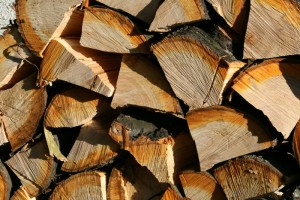While most homeowners go to great lengths to ensure that their fireplaces are properly maintained and in excellent working condition, many do not put nearly as much thought into what they’re putting into their fireplaces each season. Using the correct type of firewood – as well as wood that has been correctly seasoned and stored – can greatly improve fireplace performance and ensure that your fireplace system works well for years to come.
Firewood types
Although firewood is a generic term, each wood species has its own unique set of burning characteristics. Different species burn at different temperatures, speeds, and create varying amounts of smoke. Because of this, it is important to do research before investing in a large amount of firewood for the fall and winter.
The most popular and commonly used woods are often hardwoods. Hardwoods include species such as ash, maple, and oak, and can be identified by their broad leaves that typically change color during the fall. Hardwoods are generally preferred because they burn hotter and more steadily, producing less smoke than softwoods. However, hardwoods often light slowly, which can be a source of frustration when trying to build a warm, roaring fire.
Softwoods are typically needle-leafed trees such as firs, pines, and spruces. Because they produce more smoke when burned, softwoods are often a popular fuel for smoking meats. While their low burning temperature makes them somewhat less popular for fires, their ability to ignite quickly makes softwoods an ideal source for kindling. A prime example of this is using softwood kindling for a fire with hardwood logs.
Firewood seasoning
No matter what species of type of wood is being used, it is vitally important that the wood has been properly seasoned. Seasoned firewood is wood that has been chopped, stored, and exposed to the sun for at least 6 to 12 months. Doing this removes the moisture from the wood, allowing it to burn more efficiently and with less smoke. Wood that has not been properly seasoned will typically be hard to ignite and hiss while being burned due to the high water content in the wood.
Firewood that has been suitably seasoned will be lighter and less dense than freshly-cut wood, and banging two dried pieces together should produce a hollow, rather than dull, sound. Likewise, seasoned wood will often have cracked or split ends, indicating that the majority of the moisture has left the wood.
Firewood storage
While firewood should be exposed to sun and wind during the summer for seasoning, it needs to be protected from rain and snow during the winter. A cover, roof, or tarp can be used to protect a firewood pile and prevent snow from building up on the stack; however, whenever possible, the sides should remain open to allow air flow in the wood. This allows the seasoning process to continue and prevents a buildup of moisture. Likewise, wood should be stored off the ground to keep the bottom layer of wood dry, prevent rotting, and avoid insect infestation.
When bringing wood inside for use, only carry as much as you will immediately need. Firewood that is stored for long periods of time at room temperature can cause any dormant bugs in the wood to be become active.

